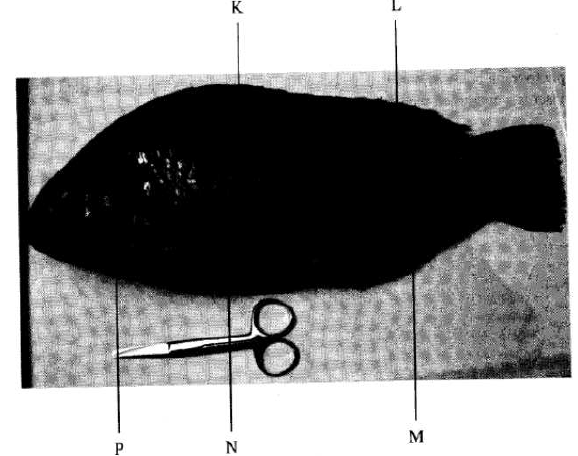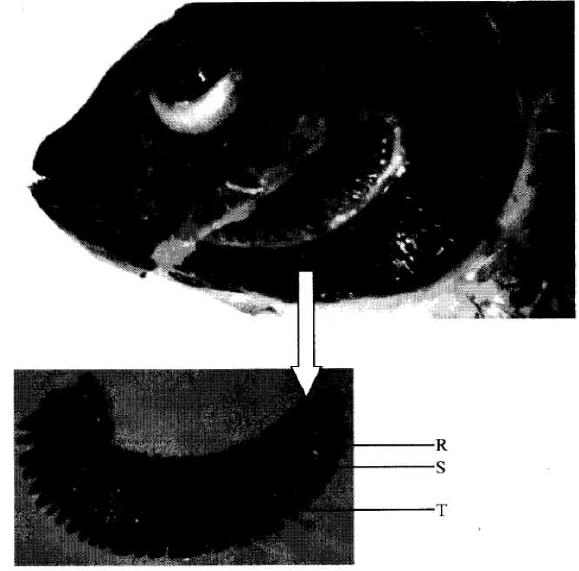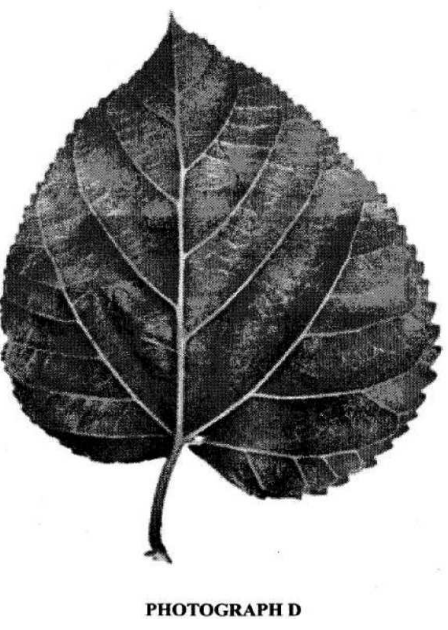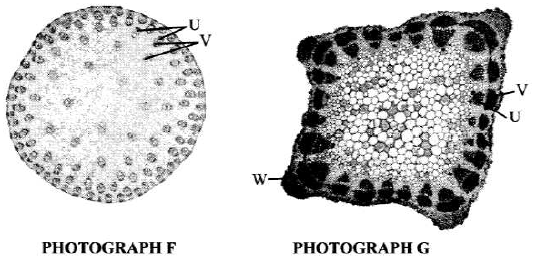- Below is a diagram of a fish. Examine it and answer the questions that follow.
- Name the parts labeled K, L, M and N. (4 marks)
- The actual length of the pair of scissors next to the fish is 12.5cm. Using this information, calculate the actual length of the fish. (3 marks)
- Name the fins that prevent the following movements of fish during swimming. (3 marks)
- Yawing
- Pitching;
- The photograph below shows visible structures after removing the part labeled P.
The inset is a magnified view of one of the structures.- Name the parts labeled R, S and T. (3 marks)
- Explain how each of the following parts named in (d) (i) above is adapted to its function. (3 marks)
- Name the parts labeled R, S and T. (3 marks)
- Name the parts labeled K, L, M and N. (4 marks)
- The photographs labeled D and E shows two types of leaves.
- With a reason, state the classes of plants from which the leaves in photographs D and E were obtained. (4 marks)
- State three features in the leaf shown in photograph D that adapt it to its functions. (3 marks)
- The photographs below show the structures observed in cross sections of parts of two types of plants as seen under a light microscope.
- Name the parts labeled U,V and W. (3 marks)
- Identify five differences between cross sections F and G. (5 marks)
- Name the parts labeled U,V and W. (3 marks)
- With a reason, state the classes of plants from which the leaves in photographs D and E were obtained. (4 marks)
- You are provided with a food sample X in solution form, solution J (Iodine solution), solution K (Benedict’s) and solution L (Biuret’s reagent). Carry out tests on the food sample to identify the type of food substances present. (9 marks)
Food being tested for Procedure Observations Conclusion
MARKING SCHEME
-
- K - Pectoral fin
L - Dorsal fin
M - Anal fin
N - Pelvic fin - The size of scissors on the photograph is 4.6
The length of fish on the photograph is 13.6 };
Mg = Image length
Actual length
Actual length of fish is 13.6 X 12.5 = 36.96 cm;
4.6 -
- Yawing - Dorsal fin;
- Pitching - Pectoral fin; Pelvic fin;
-
- R - gill rakers
S - gill bar
T - gill filaments - r - sharp/numerous/pointed/arranged closely in a row to trap solids that can damage the filaments;
S - rigid/firm to hold gill filaments in place;
T - numerous to increase surface area for gaseous exchange/thin to reduce the distance for gaseous exchange/vascularized to transport respiratory gases away from the respiratory surface moist to dissolve oxygen for diffusion;
- R - gill rakers
- K - Pectoral fin
-
- Leaf D - class dicotyledonae;
Reason - network of veins/presence of petiole;
Leaf E - class monocotyledonae;
Reason - parallel venation/presence of leaf sheath; - Broad and flat to offer a large surface area for photosynthesis;
Thin to reduce distance over which carbon IV oxide diffuses to reach the mesophyll cells;
Rich supply of veins to transport water to photosynthetic cells;
Presence of chlorophyll to absorb light for photosynthesis; -
- U - xylem;
V - phloem;
W - cambium; -
(Total = 15 marks)Cross section of F Cross section of G No pith
Vascular bundles scattered
Vascular bundles numerous
Cambium absent
Cortex absent
Small vascular bundlespith present;
vascular bundles in a ring;
vascular bundles few;
cambium present;
cortex present;
large vascular bundles;
- U - xylem;
- Leaf D - class dicotyledonae;
-
Award marks for correct procedure, observation and conclusion only.PROCEDURE OBSERVATION CONCLUSION Iodine solution/solution J
(added to the food sample drop by drop while shaking)Blue black colour formed; Starch present in food sample; Benedict's solution/ solution K added to the food sample
in test tube in equal amounts.
The test tube is then placed in a hot water bathSolution changes colour to green,yellow
and then orange/brownMore reducing sugar present in food sample Biuret's reagent/solution L added to the food sample
drop by drop while shak ing;Colour of reagent retained Protein absent in the food sample;
(9 marks)
Join our whatsapp group for latest updates
Tap Here to Download for 50/-
Get on WhatsApp for 50/-
Download KCSE 2011 Biology Paper 3 Questions with Marking Scheme.
Tap Here to Download for 50/-
Get on WhatsApp for 50/-
Why download?
- ✔ To read offline at any time.
- ✔ To Print at your convenience
- ✔ Share Easily with Friends / Students






